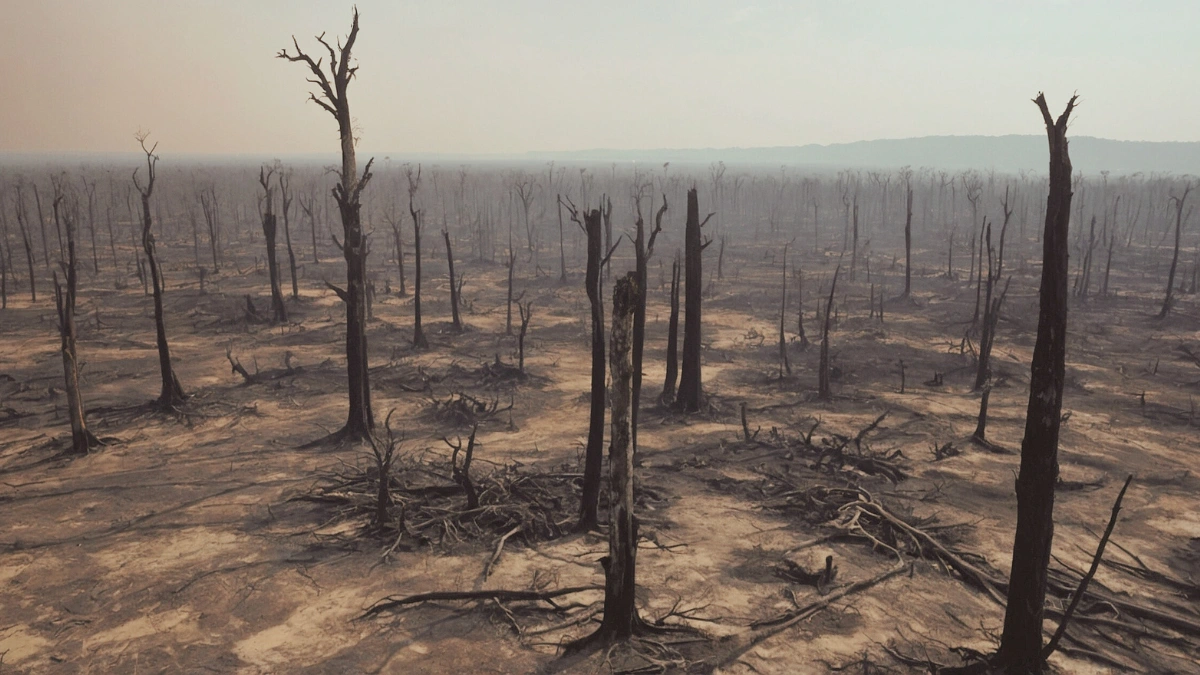Amazon in Metastasis
Amazon in Metastasis?
No, this is not an article about a scientific breakthrough involving an Amazonian plant extract that inhibits prostate cancer growth, such as BIRM.
Amazon in Metastasis is more like giving voice to a terminally ill patient—one without influential relatives, money for treatment, or access to expert care. It's not an article we take pleasure in writing. As people from the Amazon, we would rather show the beauty of our forest, its fauna, and flora. But how can we remain silent about the devastation and neglect it endures?
Although some scientists forecast the year 2050 as the tipping point of no return for the Amazon, where 10% to 47% of the rainforest could lose its regenerative capacity and become savanna-like ecosystems (DW), the increasingly frequent and large-scale events—such as the mass death of dolphins in Lake Tefé, the surge in deforestation, and biodiversity loss—suggest this estimate may be overly optimistic.
In light of this, the article Amazon in Metastasis is an honest attempt at a diagnosis. Like a medical report, it examines symptoms, names causes, and seeks to understand whether there is still time to act.
1. Visible Signs of Metastasis
The metastasis of the Amazon is not invisible. It can be seen from space, breathed in the smoke, and felt in the cracked earth and shrinking rivers. Like an ailing body, the rainforest is showing clear signs that its vital functions are failing—and many of them may already be irreversible.
The historic droughts of 2023 and 2024 in the state of Amazonas exposed riverbeds that have sustained life for centuries. The death of over 330 pink and tucuxi dolphins in Lake Tefé was not an isolated event—it was the direct result of overheating waters, severely low river levels, and a collapsed aquatic ecosystem. Experts say the 2024 drought is even worse than in 2023.
Satellite images reveal what words struggle to express. Where once stood a dense green carpet, now appear black scars like open wounds: wildfires, illegal roads, logging, and mining. These patterns expand outward like metastatic lesions in a medical scan. The phrase Amazon in Metastasis is not just a metaphor—it’s a brutally accurate description.
Studies published in Nature and reported by sources like DW and CartaCapital suggest that the forest could reach a point of no return by 2050—or even sooner. As this degradation accelerates, political contradictions deepen, turning environmental collapse into a planetary issue.
2. Vital Systems in Critical Failure
In the human body, the failure of vital systems—respiratory, circulatory, nervous—inevitably leads to death. The Amazon is no different. It’s not just losing trees; it’s losing functionality.
The most critical of these systems is the rainforest’s hydrological cycle. Amazonian trees act as natural humidity pumps, releasing water vapor into the atmosphere that feeds the so-called “flying rivers.” These atmospheric rivers irrigate vast regions of Brazil, including agricultural and urban centers. As deforestation progresses, this engine of moisture breaks down. Fewer trees mean less water vapor, fewer clouds, and more widespread droughts.
This dysfunction is already visible in distant agricultural zones. And according to Brazil’s INPE, the Amazon has ceased to be a carbon absorber—it now emits more carbon than it captures (Neo Mondo).
Amazon in Metastasis also means the collapse of biodiversity. Every hectare lost takes with it unique species, medicinal plants, pollinators, birds, mammals, and ancestral knowledge. One such example is BIRM, an Amazonian extract studied for its anti-cancer potential. How many more life-saving compounds are we losing without ever knowing they existed?
The Amazon, as a living system, is in progressive failure. And perhaps most dangerously, that failure is being normalized, managed like an economic variable rather than a planetary emergency.

3. Who Is Responsible for the Amazon’s Metastasis?
No metastasis is spontaneous. There is always an initiating factor, a period of neglect, and a system that fails to act. In the case of the Amazon, the culprits are not anonymous: they are negligent governments, corporate lobbies, and global markets that treat the forest as a resource reserve rather than a living biome.
While the international community preaches climate goals, corporations continue to finance supply chains based on deforestation, mining, land grabbing, and illegal gold extraction. Behind many exports labeled as “sustainable,” there lies a trail of destruction and contaminated rivers.
Successive Brazilian administrations are also accountable. Despite speeches about reducing deforestation, enforcement remains weak, activists are persecuted, and official messaging is manipulated for global events. The upcoming COP30 in Belém is a case in point: while the government promotes environmental leadership, it simultaneously approves infrastructure for oil exploration at the mouth of the Amazon River—a blatant contradiction.
Amazon in Metastasis is more than an ecological phenomenon. It’s a political diagnosis. It reflects inequality, strategic blindness, and a short-term mindset that puts profits above preservation.
To say the forest is terminal is not metaphor—it’s measurable, visible, and verifiable. Amazon in Metastasis is the technical term for a truth many still refuse to face, even as dead dolphins float to the surface and black smoke rises above charred canopies.
Conclusion
For decades, we said the Amazon was the “lungs of the world.” That metaphor no longer holds. Recent studies confirm that the forest now emits more carbon than it absorbs (UOL). The Amazon doesn’t breathe anymore—it suffocates. And in doing so, it drags us all down with it.
Amazon in Metastasis is not rhetorical excess. It is a fitting name for the rainforest's advanced stage of collapse. Deforestation, wildfires, biodiversity loss, drought, and illegal exploitation are no longer isolated threats; they are systemic symptoms of planetary failure.
What we face is not just an environmental crisis—it is a moral one. It reflects the failure of a generation that had access to data, science, and satellite imagery, yet chose denial or delay. Amazon in Metastasis demands more than grief—it demands action. It demands courage to confront those profiting from destruction, and urgency to defend what remains.
The forest doesn't need speeches—it needs protection. Its future is not tomorrow’s concern—it is the measure of our present decency.
Related Articles:
➤ COP30, Lula, and Oil Drilling at the Amazon River Mouth
➤ Terra do Meio Ecological Station: World's Largest Protected Tropical Forest
➤ COP30: Environmental Commitment or Political Spectacle?
